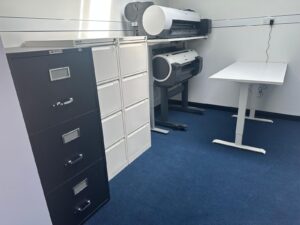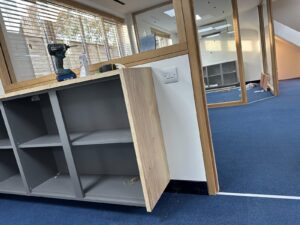Using LRV to Enhance Light, Mood, and Energy Efficiency
21 March 2025
With stricter lighting and workplace regulations, interior design is shifting towards materials with a high Light Reflectance Value (LRV). Many regions now mandate minimum lighting levels to ensure employee comfort and safety, encouraging businesses to select lighter-coloured flooring, walls, and surfaces. These surfaces maximise natural light, reduce the need for artificial lighting, and improve energy efficiency, helping businesses meet regulations while boosting productivity.
However, in high-traffic commercial spaces, darker flooring may be required due to practical concerns like dirt, stains, and safety issues. Balancing light and dark elements strategically can create a welcoming, well-lit, and functional environment.
In this article, we will explore how balancing the right combination of high-LRV materials and durable dark flooring can enhance workplace design, lighting, energy efficiency, and employee well-being.
What is LRV?
The Light Reflectance Value (LRV) Scale measures the amount of visible and useful light reflected from a surface when illuminated from a light source. In interior design and architecture, it is used to determine how much light a colour reflects or absorbs.
It is expressed on a scale from 0 to 100, where 0 represents no light reflection (black) and 100 represents total light reflection (white).

How Does LRV Affect Interior Design?
LRV plays a crucial role in creating the right atmosphere and optimising the lighting in a room. Here’s how different LRV values influence space:
Lighter Colours (Higher LRV):
- Brighten up spaces by reflecting natural and artificial light
- Give the illusion of a larger, more expansive space
- Are often associated with cleanliness, openness, and serenity
Darker Colours (Lower LRV):
- Absorb light, which can make a room feel more cosy
- Can be used to set the mood for specific areas, like conference rooms. They can also help reduce glare and create a more comfortable environment for activities that require less ambient light
- Are often seen as more sophisticated and can make a space feel more luxurious and grounded
LRV and Energy Efficiency
With increasing concerns about the need to reduce carbon emissions from fossil fuel energy, businesses are under great pressure to find ways to meet the rising demand for lighting in an energy efficient manner.
LRV plays a significant role in promoting sustainability by improving energy efficiency and reducing a building’s environmental impact. For example, materials with a high LRV reflect more natural light into a space, reducing the need for artificial lighting during the day. Also, they may improve thermal comfort by reflecting heat, reducing the need for air conditioning or heating. This helps decrease electricity consumption, which lowers energy costs, and the environmental impact associated with powering lights.

In addition to energy savings, incorporating high LRV materials can contribute to achieving green building certifications like LEED. Thus, choosing materials with the right LRV can help businesses, designers, and architects meet long-term sustainability goals for commercial spaces while also improving building performance.
How Does LRV Affect Visual Comfort?
LRV plays a crucial role in how comfortable and accessible a space is. Too many light surfaces can lead to eye strain, making the environment less pleasant to be in, while a well-balanced LRV can reduce glare and create a visually soothing atmosphere.

A thoughtful contrast between surfaces and objects, such as doors, can help people with reduced eyesight navigate their surroundings more easily. For the visually impaired, the amount of light a surface reflects significantly impacts its visibility, making LRV an essential consideration in ensuring that spaces are both functional and accessible for all.
Compliance with Standards
In the UK, workplace lighting standards are regulated by The Workplace (Health, Safety, and Welfare) Regulations 1992:
- Regulation 8 of these regulations’ states that every workplace must be adequately lit to allow employees to work safely
- The regulation emphasises that the lighting should avoid glare, and provide sufficient contrast to ensure that work activities can be performed quickly
Finding the Right Balance Between Light and Dark
In high-traffic commercial spaces, darker coloured flooring is preferred as they tend to mask dirt, stains, and wear better than lighter colours. In busy environments like offices, retail spaces, or staircases, where spills are common, dark carpets can maintain a cleaner appearance for longer periods, reducing the frequency of cleaning or replacement.
However, because dark colours have a lower LRV, and thus absorb light, it’s important to strategically blend both light and dark elements to create a welcoming and balanced atmosphere. For example, pairing dark carpets with lighter walls or ceilings can help improve the overall brightness of the space, as they reflect more light back into the room.
In a recent project, A.D. Broughton, a heating and plumbing company, opted for Supacord sheet carpet, in the colour Indigo, for their office flooring. Since the office’s walls and ceilings are white, the business added darker flooring to add warmth to the space. This created a harmonious contrast which maintained a balanced atmosphere, without making the space feel too dark.


A key advantage of dark carpets is their ability to reduce glare and provide a more comfortable visual experience, even though they may not have a high LRV. Despite this, dark carpets can still be used effectively in creating a well-lit environment, especially as businesses focus on employee health and well-being. By using materials with varying LRVs, they can help reduce eye strain and promote mental clarity.
Consequently, incorporating dark tones into commercial designs does not mean sacrificing openness and brightness, if there is a contrast which can help guide the tone of the space. In commercial areas, many businesses require a dark floor and no longer need to worry that this will affect the productivity of the space.
Conclusion
In summary, understanding LRV helps designers and architects make informed decisions when selecting materials and colours. It’s not just about aesthetics; it’s also about the functionality of a space, by affecting lighting, mood, and energy use. By understanding the LRV of different materials, like paint, carpet, or furniture, designers can create a more efficient, functional, and aesthetically pleasing environment.
Ready to enhance your next project with LRV in mind? Order a free sample to experiment with different colour contrasts and see the impact of LRV in action!
